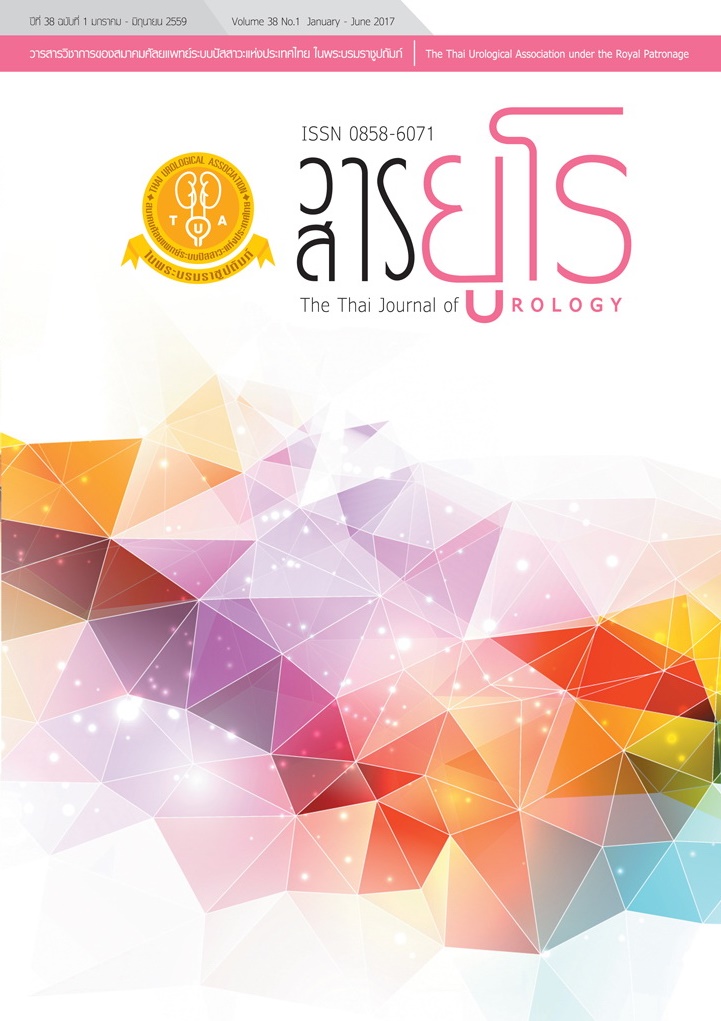Outcomes of low-dose-rate brachytherapy for clinically localized prostate cancer: Phramongkutklao Hospital
Keywords:
Localized Prostate Cancer, Low-dose-rate Brachytherapy, Biochemical Outcome, Overall Survival, มะเร็งต่อมลูกหมากระยะจำกัดภายในต่อมลูกหมาก, การฝังแร่รังสีรักษาระยะใกล้ด้วยอัตราปริมาณรังสีต่ำAbstract
Objective: To report outcomes of patients treated with I125 low-dose-rate brachytherapy (BT) for clinically localized prostate cancer.
Material and methods: Retrospective cohort in a single university hospital in Thailand was performed in a group of 133 patients with clinically localized prostate cancer treated with I125 BT between 2002 and 2014 at Phramongkutklao Hospital. The records of 133 patients with a minimum of 1 year follow-up were reviewed. Cohorts were categorized according to the National Comprehensive Cancer Network risk classification (NCCN). Biochemical outcomes and overall survival were examined. Biochemical failure was defined as nadir prostate-specific antigen (PSA) level plus 2 ng/mL. Univariate and multivariate Cox proportion hazards were used to determine the predictors of biochemical failure.
Results: A total of 133 patients met the criteria with a mean follow-up of 47.87 + 30.05 months. The mean age was 68.02 + 8.34 years. Both of the 5 and 7 year overall survival rates were 100% and biochemical failure-free survival rates were 96.0% and 89.5%, respectively. A multivariate analysis revealed no significant predictors of biochemical failure in this study
Conclusion: I125 low-dose-rate BT resulted in excellent survival and morbidity outcomes for localized prostate cancer at a single hospital. Further studies are required in order to obtain long-term outcome data.
การรักษามะเร็งต่อมลูกหมากในระยะจำกัดภายในต่อมลูกหมาก ด้วยวิธีฝังแร่รังสีรักษาระยะใกล้ด้วยอัตราปริมาณรังสีต่ำ ในโรงพยาบาลพระมงกุฎเกล้า
วีรยุทธ์ วิริยะบัณฑิตกุล, วีร์ลักษณ์ เลิศไพรวัน, บัณฑิต กาญจนพยัฆ
หน่วยศัลยกรรมระบบปัสสาวะ กองศัลยกรรม โรงพยาบาลพระมงกุฎเกล้า กรุงเทพ ฯ
บทคัดย่อ
วัตถุประสงค์: เพื่อรายงานผลการรักษามะเร็งต่อมลูกหมากระยะจำกัดภายในต่อมลูกหมาก ด้วยวิธีการฝังแร่รังสีรักษาระยะใกล้ ด้วยอัตราปริมาณรังสีต่ำ
ผู้ป่วยและวิธีการศึกษา: ทำการศึกษาผู้ป่วยมะเร็งต่อมลูกหมากยังอยู่ภายในต่อมลูกหมากที่ได้รับการรักษาด้วยวิธีการฝังแร่รังสี รักษาระยะใกล้ด้วยอัตราปริมาณรังสีต่ำ ตั้งแต่เดือนตุลาคม พ.ศ. 2545 ถึงเดือนธันวาคม พ.ศ. 2557 เลือกเฉพาะผู้ป่วยที่มา ติดตามอาการอย่างน้อย 12 เดือน และติดตามผู้ป่วยที่เข้าตามข้อกำหนด โดยแบ่งความเสี่ยงตาม National Comprehensive Cancer Network (NCCN) ติดตามอัตราการรอดชีวิต (overall survival) และอัตราการปราศจากภาวะล้มเหลวของค่าจำเพาะ ต่อต่อมลูกหมาก (biochemical failure: PSA สูงกว่าค่า PSA ที่ต่ำที่สุด 2 ng/mL)
ผลการศึกษา: ผู้ป่วยจำนวน 133 ราย มีค่าเฉลี่ยการติดตามที่ 47.87 + 30.5 เดือน ค่าเฉลี่ยอายุ 68.02 + 8.34 ปี อัตราการรอด ชีวิตที่ 5 และ 7 ปี เท่ากับร้อยละ 100 และ ร้อยละ 100 ตามลำดับ อัตราการปราศจากภาวะล้มเหลวของค่าจำเพาะต่อต่อมลูก หมากที่ 5 และ 7 ปี เท่ากับ ร้อยละ 96.0 และ ร้อยละ 89.5 ตามลำดับ จากการวิเคราะห์ univariate analysis และ multivariate analysis ไม่พบปัจจัยที่มีผลต่อการเกิด biochemical failure อย่างมีนัยสำคัญทางสถิติ
สรุป: การรักษามะเร็งต่อมลูกหมากระยะจำกัดภายในต่อมลูกหมาก ด้วยวิธีการฝังแร่รังสีรักษาระยะใกล้ด้วยอัตราปริมาณรังสี ต่ำ มีอัตราการรอดชีวิต อัตราการล้มเหลวของค่าจำเพาะต่อต่อมลูกหมาก และผลข้างเคียงจากการรักษา อยู่ในเกณฑ์ที่ดีมาก อย่างไรก็ตาม การศึกษานี้ เป็นการศึกษาในโรงพยาบาลเดียวเท่านั้น การศึกษาเพิ่มเติมจะทำให้ได้ผลการติดตามที่เป็นประโยชน์ มากขึ้น


